The Influence of Stochastic Resonance Whole-Body Vibration on Women over 50 Years of Age—Preliminary Studies Based on Patients’ Own Experiences
Abstract
1. Introduction
2. Materials and Methods
Statistical Analysis
3. Results
4. Discussion
Limitations of the Study
5. Conclusions
Author Contributions
Funding
Institutional Review Board Statement
Informed Consent Statement
Data Availability Statement
Conflicts of Interest
References
- Marchewka:, A.; Dąbrowski, Z.; Żołądź, J.A. Physiology of Aging. Prevention and Rehabilitation; PWN: Warszawa, Poland, 2012; pp. 3–86. (In Polish) [Google Scholar]
- Thurston, R.C.; Karvonen-Gutierrez, C.A.; Derby, C.A.; El Khoudary, S.R.; Kravitz, H.M.; Manson, J.E. Menopause versus chronologic aging: Their roles in women’s health. Menopause 2018, 25, 849–854. [Google Scholar] [CrossRef]
- El Khoudary, S.R.; Greendale, G.; Crawford, S.L.; Avis, N.E.; Brooks, M.M.; Thurston, R.C.; Karvonen-Gutierrez, C.; Waetjen, L.E.; Matthews, K. The menopause transition and women’s health at midlife: A progress report from the Study of Women’s Health Across the Nation (SWAN). Menopause 2019, 26, 1213. [Google Scholar] [CrossRef]
- Salamat, M.R.; Salamat, A.H.; Janghorbani, M. Association between Obesity and Bone Mineral Density by Gender and Menopausal Status. Endocrinol. Metab. 2016, 31, 547–558. [Google Scholar] [CrossRef]
- Central Statistical Office. Life expectancy tables of Poland 2019. Available online: https://stat.gov.pl/download/gfx/portalinformacyjny/en/defaultaktualnosci/3288/2/13/1/life_expectancy_2020.pdf (accessed on 22 April 2021). (In Polish)
- Borysiak, K.; Broś, A.; Czekaj, A.; Gadocha, K.; Jasiówka, A.; Jurek, J.; Klimończyk, J.; Motyka, K.; Woch, P. Health of women in Poland in 2004–2009; Central Statistical Office of Poland, Statistical Office in Krakow: Krakow, Poland, 2012. Available online: https://stat.gov.pl/download/cps/rde/xbcr/gus/ZO_Zdrowie_kobiet_w_Polsce_w_latach_2004-2009.pdf (accessed on 17 October 2020). (In Polish)
- Calim, A.; Palabas, T.; Uzuntarla, M. Stochastic and vibrational resonance in complex networks of neurons. Philos. Trans. R. Soc. A Math. Phys. Eng. Sci. 2021, 379, 20200236. [Google Scholar] [CrossRef] [PubMed]
- Rogan, S.; Radlinger, L.; Portner-Burkhalter, C.; Sommer, A.; Schmidtbleicher, D. Feasibility study evaluating four weeks stochastic resonance whole-body vibration training with healthy female students. Int. J. Kinesiol. Sports Sci. 2013, 1, 1–9. [Google Scholar]
- Rogan, S.; Taeymans, J.; Radlinger, L. Effects of whole-body vibration on postural control in elderly: An update of a systematic review and meta-analysis. Arch. Gerontol. Geriatr. 2017, 73, 95–112. [Google Scholar] [CrossRef] [PubMed]
- Rutkowski, S.; Szczegielniak, J. Stochastic resonance in physiotherapy. Prakt. Fizjoter. Rehabil. 2013, 42, 26–28. (In Polish) [Google Scholar]
- Donocik, K.; Hartman-Petrycka, M.; Lebiedowska, A.; Błońska-Fajfrowska, B. Alterations in the ability to maintain balance as a result of stochastic resonance whole body vibration in women. PLoS ONE 2017, 12, e0185179. [Google Scholar] [CrossRef] [PubMed]
- Rogan, S.; Radlinger, L.; Baur, H.; Schmidtbleicher, D.; de Bie, R.A.; de Bruin, E.D. Sensory-motor training targeting motor dysfunction and muscle weakness in long-term care elderly combined with motivational strategies: A single blind randomized controlled study. Eur. Rev. Aging Phys. Act. 2016, 13, 4. [Google Scholar] [CrossRef] [PubMed]
- Yu, P.A.; Hsu, W.H.; Hsu, W.B.; Kuo, L.T.; Lin, Z.R.; Shen, W.J.; Hsu, R.W.W. The effects of high impact exercise intervention on bone mineral density, physical fitness, and quality of life in postmenopausal women with osteopenia: A retrospective cohort study. Medicine 2019, 98, e14898. [Google Scholar] [CrossRef] [PubMed]
- Żakowska-Wachelko, B. Outline of Geriatric Medicine; PZWL: Warszawa, Poland, 2000. (In Polish) [Google Scholar]
- Nazar, K.; Kaciuba-Uściłko, H. The importance of physical activity in the prevention of lifestyle diseases. In Physiological Basis of Exercise; Górski, J., Ed.; PZWL: Warsaw, Poland, 2006; pp. 546–548. (In Polish) [Google Scholar]
- Zhang, L.; Weng, C.; Liu, M.; Wang, Q.; Liu, L.; He, Y. Effect of whole-body vibration exercise on mobility, balance ability and general health status in frail elderly patients: A pilot randomized controlled trial. Clin. Rehabil. 2014, 28, 59–68. [Google Scholar] [CrossRef]
- Rogan, S.; Hilfiker, R.; Schmid, S.; Radlinger, L. Stochastic resonance whole-body vibration training for chair rising performance on untrained elderly: A pilot study. Arch. Gerontol. Geriatr. 2012, 55, 468–473. [Google Scholar] [CrossRef]
- Herren, K.; Schmid, S.; Rogan, S.; Radlinger, L. Effects of Stochastic Resonance Whole-Body Vibration in Individuals with Unilateral Brain Lesion: A Single-Blind Randomized Controlled Trial: Whole-Body Vibration and Neuromuscular Function. Rehabil. Res. Pract. 2018, 2018, 9319258. [Google Scholar] [CrossRef]
- Borello-France, D.F.; Zyczynski, H.M.; A Downey, P.; Rause, C.R.; A Wister, J. Effect of Pelvic-Floor Muscle Exercise Position on Continence and Quality of life Outcomes in Women with Stress Urinary Incontinence. Phys. Ther. 2006, 86, 974–986. [Google Scholar] [CrossRef] [PubMed]
- Chmielewska, D.; Kwaśna, K.; Piecha, M.; Halski, T.; Taradaj, J.; Kubacki, J.; Skrzypulec-Plinta, V. Selected methods of conservative treatment of stress urinary incontinence: Current views. Part 1. Menopausal Rev. 2012, 4, 264–268. (In Polish) [Google Scholar] [CrossRef]
- Kwaśna, K.; Chmielewska, D.; Piecha, M.; Halski, T.; Taradaj, J.; Juras, G.; Skrzypulec-Plinta, V. Physiotherapy treatment of urinary stress incontinence in women. Part 2. Menopausal Rev. 2012, 11, 372–375. (In Polish) [Google Scholar] [CrossRef]
- Lauper, M.; Kuhn, A.; Gerber, R.; Luginbühl, H.; Radlinger, L. Pelvic Floor Stimulation: What are the good vibrations? Neurourol. Urodyn. 2009, 28, 405–410. [Google Scholar] [CrossRef] [PubMed]
- Runge, E. Urinary incontinence treatment methods. Overcoming the taboo. Der Hausartz 2002, 2, 56–61. (In German) [Google Scholar]
- Luginbuehl, H.; Lehmann, C.; Gerber, R.; Kuhn, A.; Hilfiker, R.; Baeyens, J.P.; Radlinger, L. Continous versus intermittent stochastic resonance whole body vibration and its effect on pelvic floor muscle activity. Neurourol. Urodyn. 2012, 31, 683–687. [Google Scholar] [CrossRef] [PubMed]
- Elfering, A.; Thomann, J.; Schade, V.; Radlinger, L. Stochastic resonance whole body vibration reduces musculoskeletal pain: A randomized controlled trial. World J. Orthop. 2011, 2, 116–120. [Google Scholar] [CrossRef]
- Elfering, A.; Burger, C.; Schade, V.; Radlinger, L. Stochastic resonance whole body vibration increases perceived muscle relaxation but not cardiovascular activation: A randomized controlled trial. World J. Orthop. 2016, 7, 758–765. [Google Scholar] [CrossRef] [PubMed]
- Monteleone, G.; De Lorenzo, A.; Sgroi, M.; De Angelis, S.; Di Renzo, L. Contraindications for whole body vibration training: A case of nephrolithiasis. J. Sports Med. Phys. Fitness 2007, 47, 443–445. [Google Scholar]
- Bogaerts, A.; Verschueren, S.; Delecluse, C.; Claessens, A.L.; Boonen, S. Effects of whole body vibration training on postural control in older individuals: A 1 year randomized controlled trial. Gait Posture 2007, 26, 309–316. [Google Scholar] [CrossRef] [PubMed]
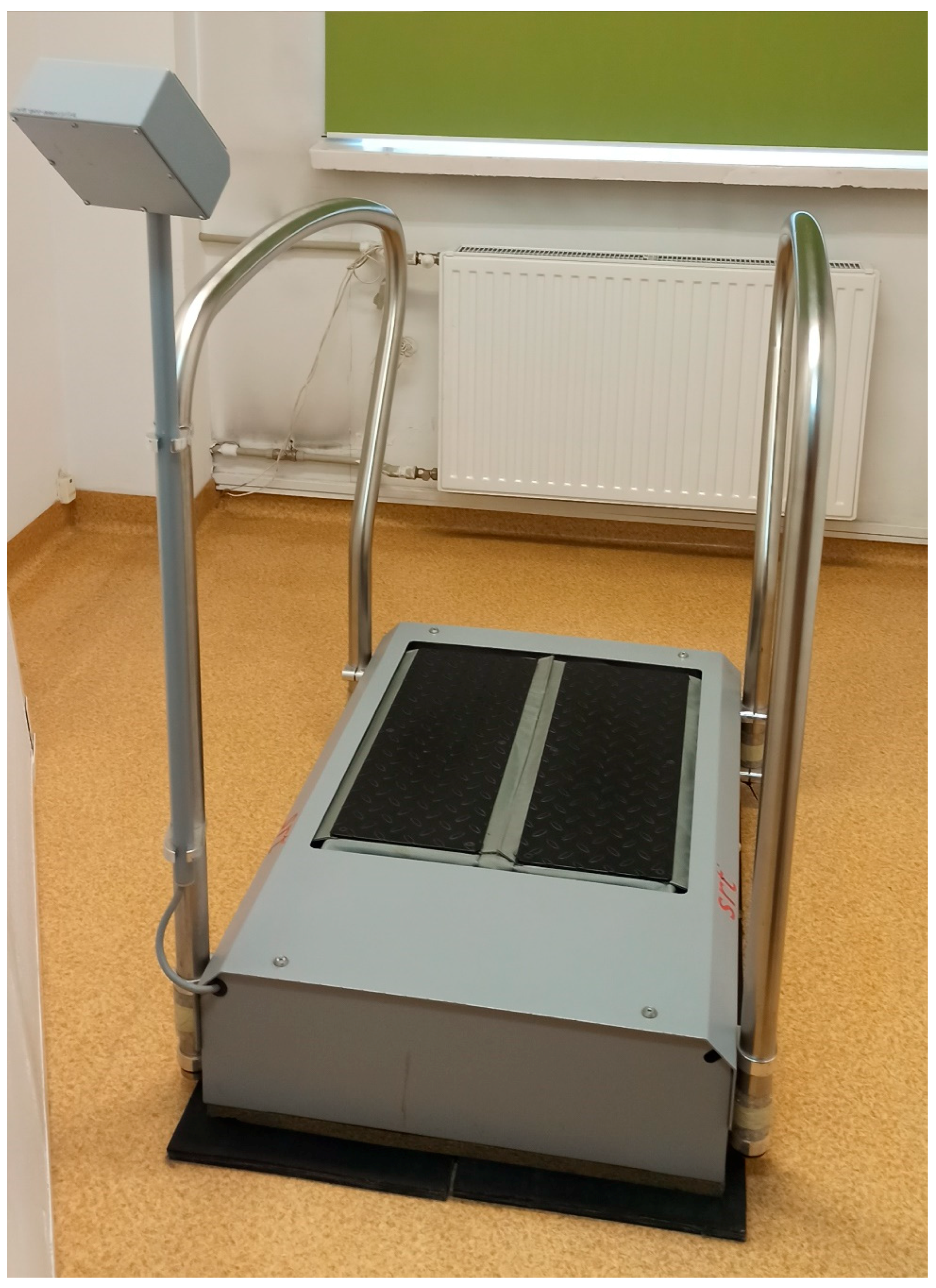
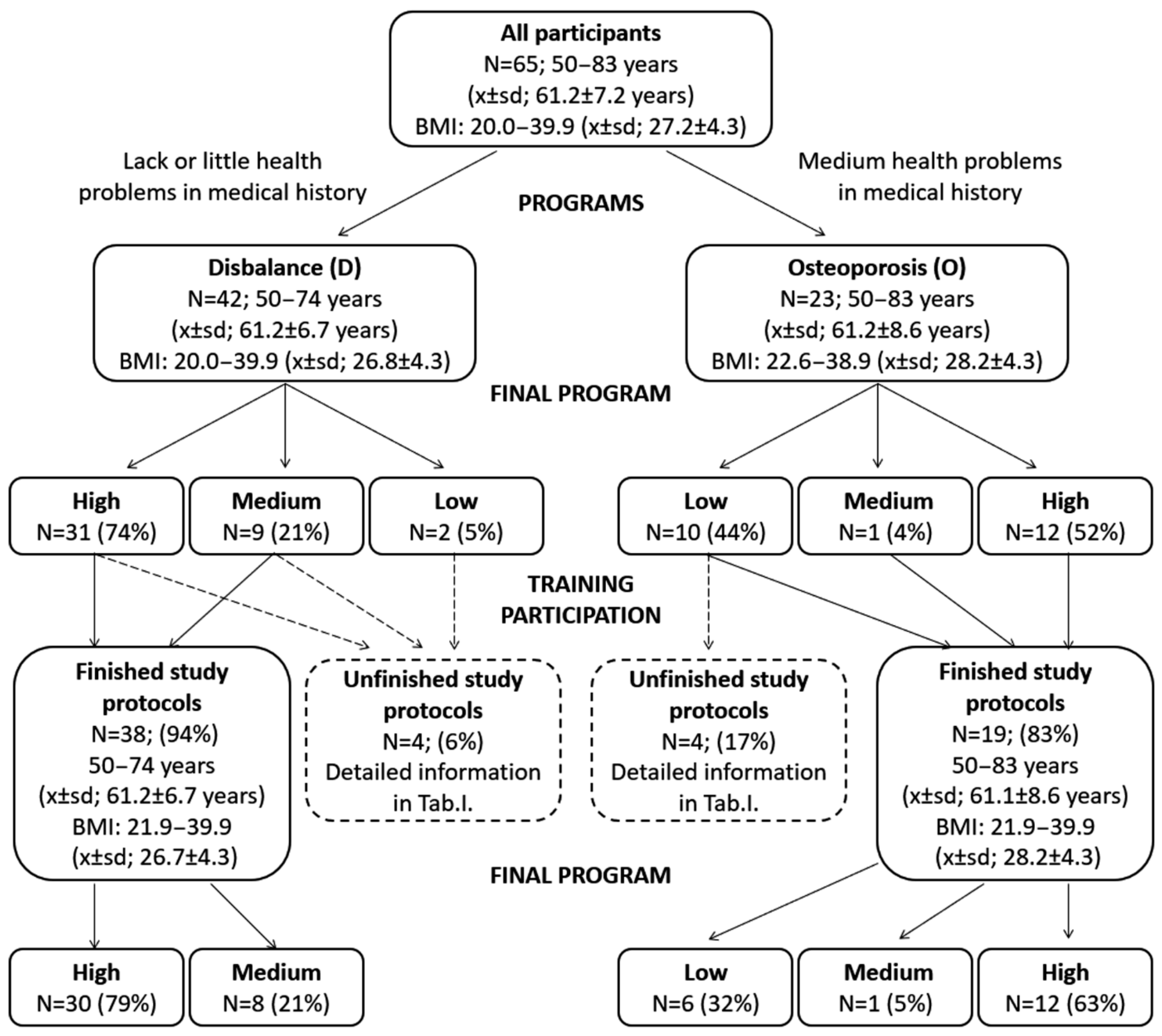
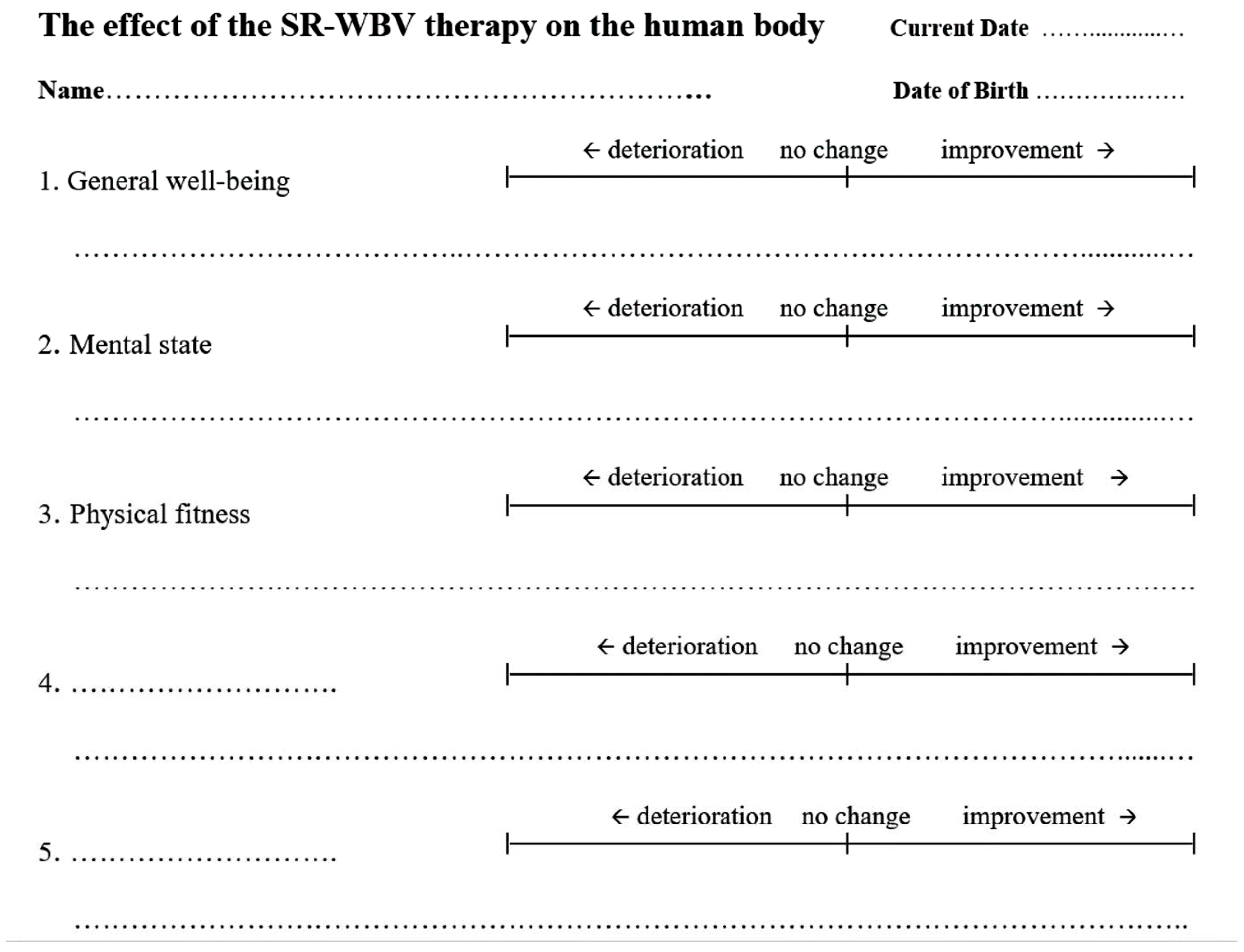
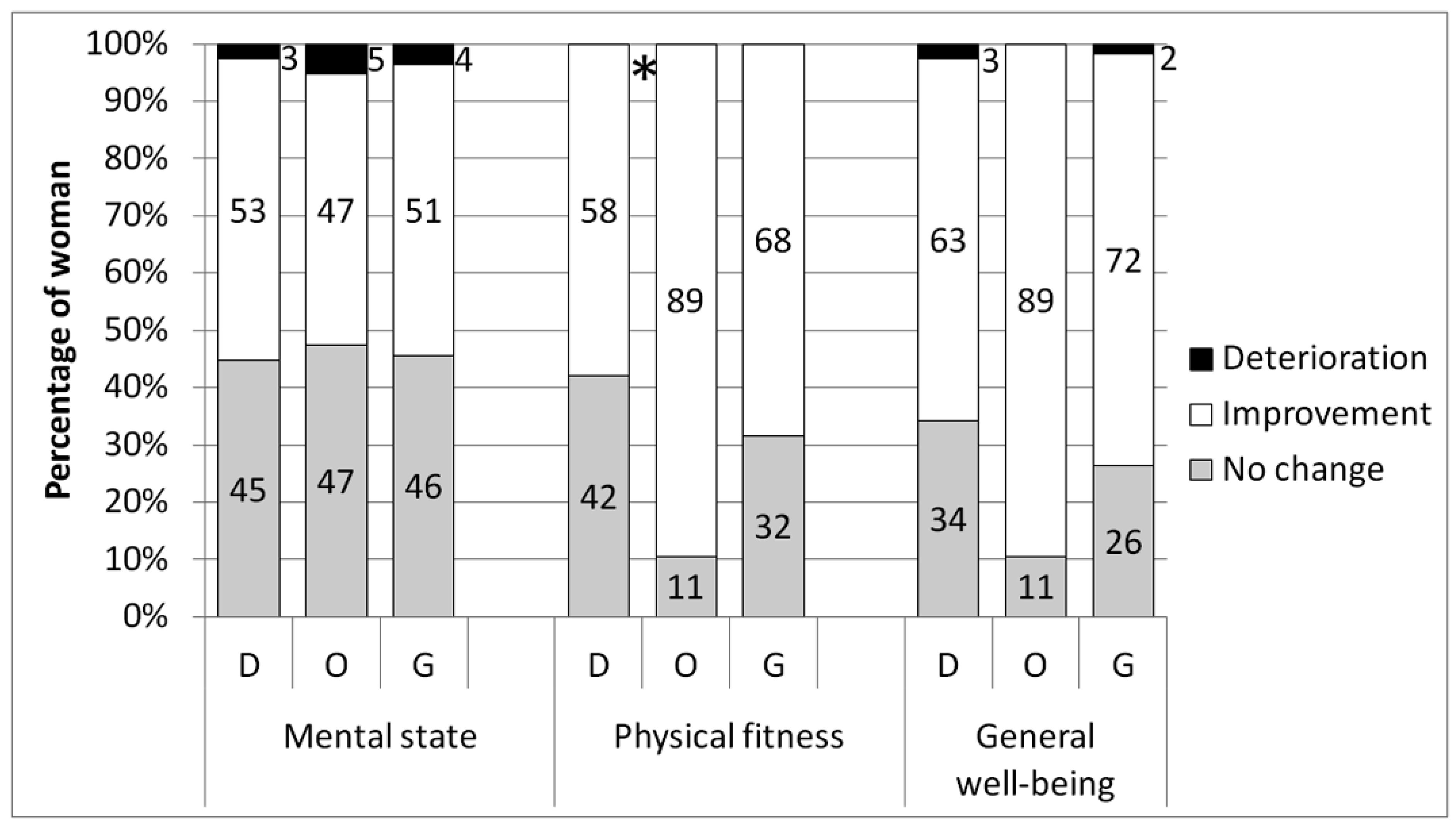
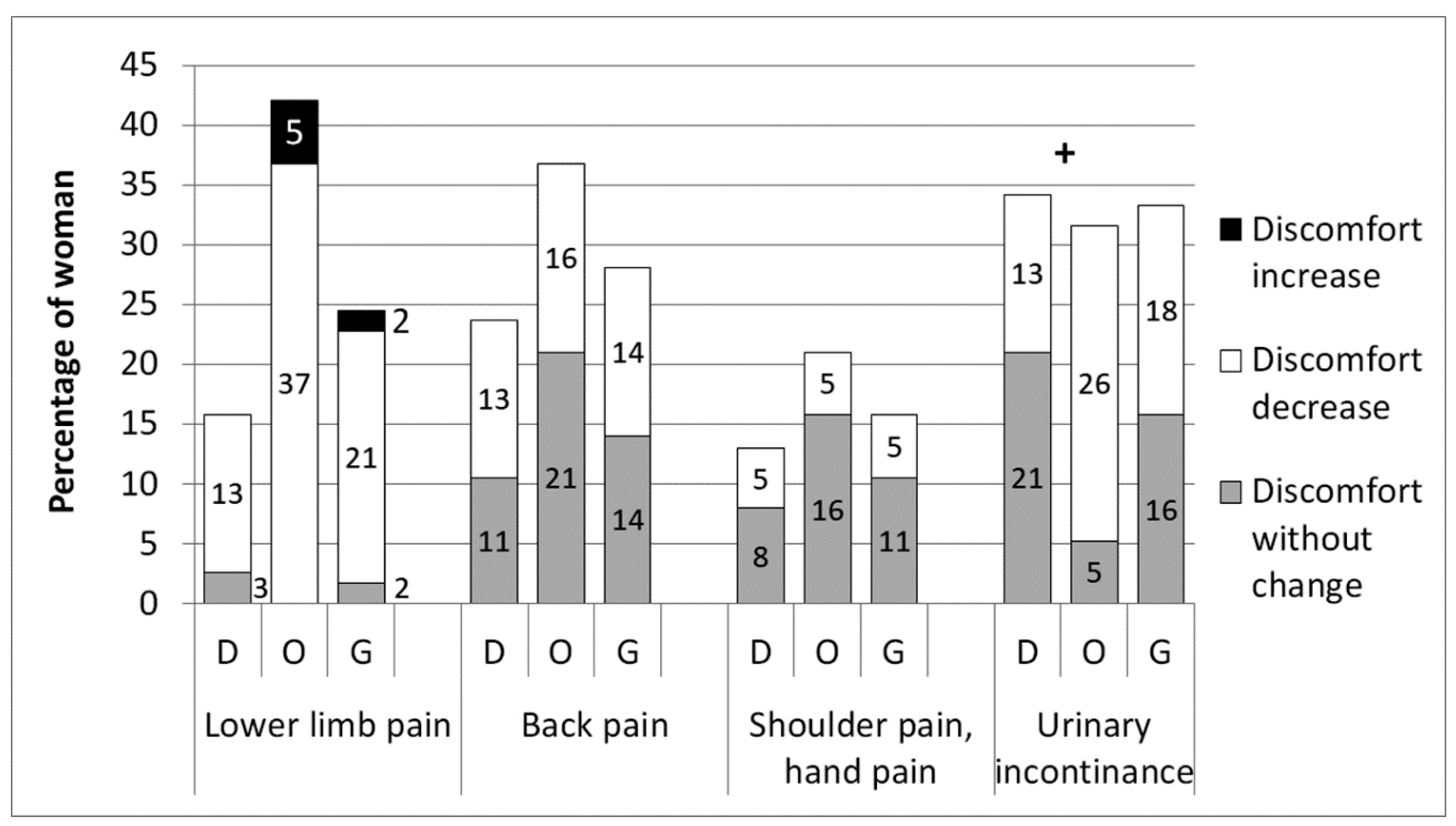
| No. | Program | Number of Sessions/Level | Age | Health Problem in Medical History | Reason for Quitting the Training |
|---|---|---|---|---|---|
| 1 D | Disbalance | 1/Medium, 1/High | 52 | No medical history of health problems | Back pain |
| 2 D | 1/Medium | 52 | Surgery for hernia and vermiform appendix | Hyperthyroidism | |
| 3 D | 4/Low | 74 | Overweight, knee pain when climbing stairs, arterial hypertension treated pharmacologically, heart arrhythmia | Heart arrhythmia (hospitalization) | |
| 4 D | 3/Low | 62 | Class II obesity | Knee pain, dizziness | |
| 1 O | Osteoporosis | 2/Low | 65 | Obesity, thoracic and cervical back pain, knee pain caused by weather changes, depression, dizziness, hypertension, arrhythmia | Knee pain |
| 2 O | 4/Low | 60 | Overweight, discopathy with no current pain, hypertension, diabetes | Nausea and vomiting | |
| 3 O | 4/Low | 70 | Overweight, displaced fractures of left lower leg, lower extremity edema, hypertension, arrhythmias, removed varicose veins, urinary incontinence | Back pain, numbness of hands | |
| 4 O | 1/Low | 57 | Musculoskeletal pain, degenerative changes in the spine | Arthritis |
| Effects Listed by Women after SR-WBV Training | D | O | G | |||
|---|---|---|---|---|---|---|
| N | % | N | % | N | % | |
| Increase in energy and physical condition | 3 | 8 | 3 | 16 | 6 | 11 |
| Skin firming, cellulite reduction | 5 | 13 | 1 | 5 | 6 | 11 |
| Improvement in sleep quality and in falling asleep | 2 | 5 | 2 | 11 | 4 | 7 |
| Concentration improvement | 2 | 5 | - | - | 2 | 4 |
| Calming and silencing effect | 2 | 5 | - | - | 2 | 4 |
| Quicker bruises healing | 1 | 3 | 1 | 5 | 2 | 4 |
| Less headaches | 1 | 3 | 1 | 5 | 2 | 4 |
| Less severe headaches and menstrual cramps during menstruation | - | - | 1 | 5 | 1 | 2 |
| Balance improvement while climbing stairs | 1 | 3 | - | - | 1 | 2 |
| Dizziness reduction while rising from bed | 1 | 5 | - | - | 1 | 2 |
| Reduction in tingling and tickling of the skin | - | - | 1 | 5 | 1 | 2 |
| Lower hypertension | 1 | 5 | - | - | 1 | 2 |
| Lower body weight | 1 | 5 | - | - | 1 | 2 |
| Hemorrhoids reduction | 1 | 5 | - | - | 1 | 2 |
| Sharpen eyesight | 1 | 5 | - | - | 1 | 2 |
| Constipation improvement | - | - | 1 | 5 | 1 | 2 |
| Easier breathing | - | - | 1 | 5 | 1 | 2 |
| Higher hypertension | - | - | 1 | 5 | 1 | 2 |
Publisher’s Note: MDPI stays neutral with regard to jurisdictional claims in published maps and institutional affiliations. |
© 2021 by the authors. Licensee MDPI, Basel, Switzerland. This article is an open access article distributed under the terms and conditions of the Creative Commons Attribution (CC BY) license (https://creativecommons.org/licenses/by/4.0/).
Share and Cite
Hartman-Petrycka, M.; Lebiedowska, A.; Stolecka-Warzecha, A.; Szumski, A.; Błońska-Fajfrowska, B. The Influence of Stochastic Resonance Whole-Body Vibration on Women over 50 Years of Age—Preliminary Studies Based on Patients’ Own Experiences. Appl. Sci. 2021, 11, 3980. https://doi.org/10.3390/app11093980
Hartman-Petrycka M, Lebiedowska A, Stolecka-Warzecha A, Szumski A, Błońska-Fajfrowska B. The Influence of Stochastic Resonance Whole-Body Vibration on Women over 50 Years of Age—Preliminary Studies Based on Patients’ Own Experiences. Applied Sciences. 2021; 11(9):3980. https://doi.org/10.3390/app11093980
Chicago/Turabian StyleHartman-Petrycka, Magdalena, Agata Lebiedowska, Anna Stolecka-Warzecha, Andrzej Szumski, and Barbara Błońska-Fajfrowska. 2021. "The Influence of Stochastic Resonance Whole-Body Vibration on Women over 50 Years of Age—Preliminary Studies Based on Patients’ Own Experiences" Applied Sciences 11, no. 9: 3980. https://doi.org/10.3390/app11093980
APA StyleHartman-Petrycka, M., Lebiedowska, A., Stolecka-Warzecha, A., Szumski, A., & Błońska-Fajfrowska, B. (2021). The Influence of Stochastic Resonance Whole-Body Vibration on Women over 50 Years of Age—Preliminary Studies Based on Patients’ Own Experiences. Applied Sciences, 11(9), 3980. https://doi.org/10.3390/app11093980






